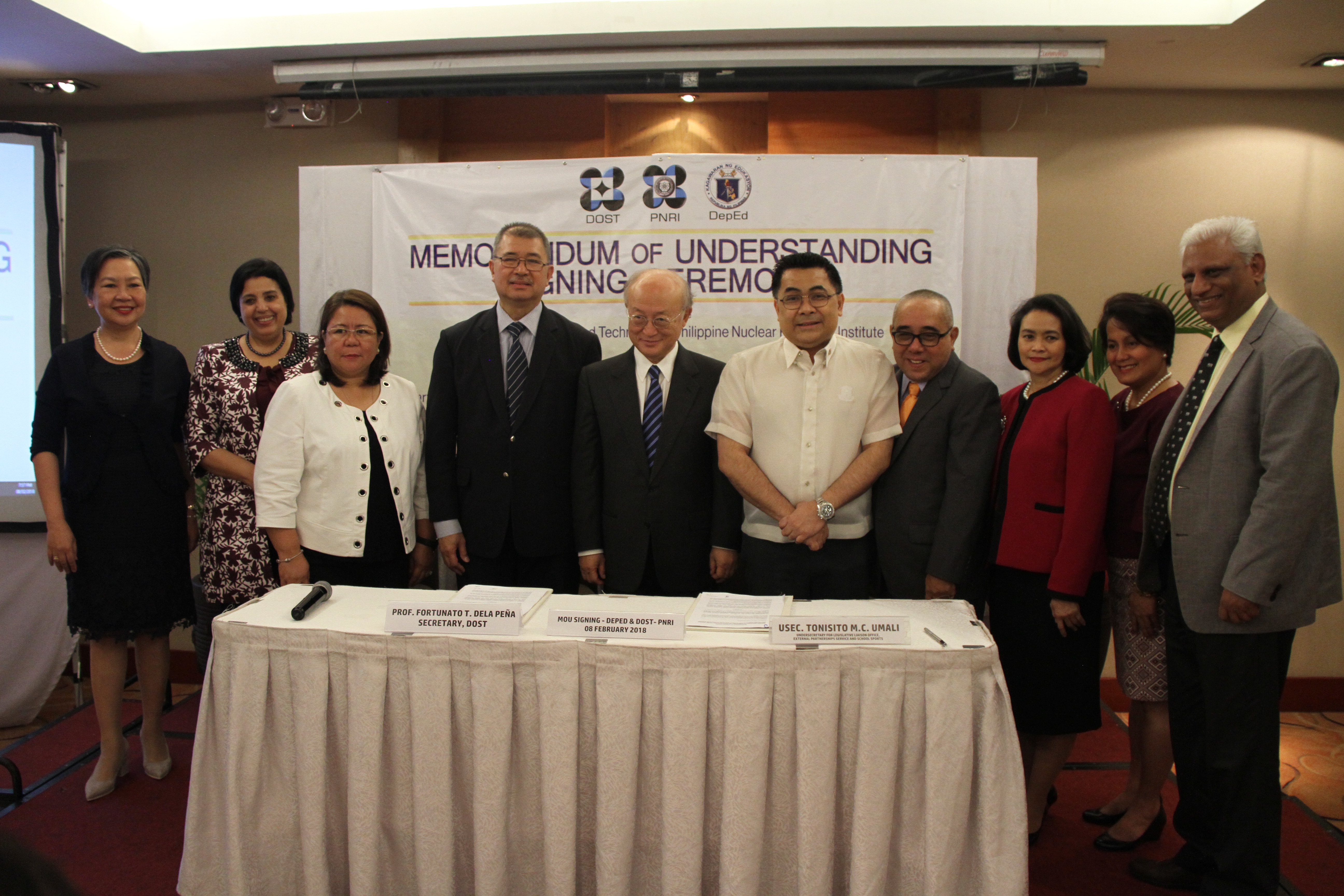
Officials from the International Atomic Energy Agency, Department of Science and Technology and Department of Education pose for a group photo after the Memorandum of Understanding signing ceremony: IAEA Director General Yukiya Amano (5th from left), Secretary Fortunato De La Peña of the Department of Science and Technology (DOST) (4th from left), Undersecretary Tonisito Umali of the Philippines’ Department of Education (DepEd) (5th from right), Ambassador Maria Cleofe Natividad, Permanent Representative of the Philippines to the IAEA (3rd from right), DOST Undersecretary Dr. Rowena Cristina Guevara (3rd from left), IAEA Department of Technical Cooperation Director of the Division of Asia and the Pacific Dr. Najat Mokhtar (2nd from left), DOST-Philippine Nuclear Research Institute Director Dr. Carlo Arcilla (4th from right), DepEd External Partnerships Service Director Dr. Margarita Ballesteros (2nd from right), IAEA Department of Technical Cooperation Division of Asia and the Pacific Section Head and Project Management Officer Dr. Jane Gerardo-Abaya (extreme left) and IAEA Technical Officer Dr. Sunil Sabharwal (extreme right).
DOST – PNRI Partners with DepEd in IAEA Regional Technical Cooperation Project on Nuclear Science and Technology Education
Taking the next great stride in the teaching of nuclear science and technology in secondary schools, the Philippines officially engages in an International Atomic Energy Agency (IAEA) education project through a Memorandum of Understanding (MOU) between its science and education departments.
The document, which was signed on February 8, establishes the partnership between the Department of Education (DepEd) and the Department of Science and Technology – Philippine Nuclear Research Institute (DOST-PNRI) in implementing the IAEA Regional Technical Cooperation Project RAS0079 on Educating Secondary Students and Science Teachers on Nuclear Science and Technology.
The signatories were DOST Secretary Fortunato De La Peña and DepEd Secretary Dr. Leonor Briones, who each holds important leadership positions in the cabinet, and are indispensable to the national scope of the project’s implementation. DepEd Undersecretary Tonisito Umali was present in Dr. Briones’ behalf during the signing ceremony.
IAEA Director General Yukiya Amano, who visited the Philippines on February 7 to 11, was also one of the witnesses in the signing of the MOU, which served as another milestone in the history of Atoms for Peace and Development in the country.
“The Philippines has been a very active member of the IAEA since 1958, the year that the Agency was established in Vienna,” Director General Amano said. The IAEA has various Technical Cooperation projects which were completed or are currently ongoing in the Philippines, which is now privileged to be the designated host country for the new IAEA education project.
The objective of the IAEA technical cooperation project is to help increase the interest of students in the Asia - Pacific region regarding science and technology in general, eventually leading to future careers in Science, Technology, Engineering and Mathematics (STEM). It also seeks to provide a more accurate perspective of nuclear concepts among secondary school students and a better understanding of nuclear and radiation applications in their daily lives.
“I am confident that this project will lead to an increase in the number of bright young people who will take up their studies in the nuclear field in the coming years. They will then be well-placed to contribute to the health, well-being and prosperity of their countries” said Director General Amano, as he lauded the potential of students across the Asia-Pacific region to contribute to the regional development.
Also present during the signing ceremony were DepEd External Partnerships Service Director Margarita Ballesteros and DOST-PNRI Director Dr. Carlo Arcilla, as well as several officials from IAEA and the Philippine government, and around 30 foreign and local education representatives from 19 countries participating in the concurrent Regional Workshop on Curriculum Development and Launching of Nuclear Science and Technology for Secondary Schools being conducted from February 5 to 9.
The four-year project will facilitate the training of secondary science teachers and students on nuclear S&T throughout the IAEA Member States through scientific visits, hosting of expert missions and the conduct of regional and national seminars and workshops. Educational and learning resource materials on nuclear science will also be developed in various formats.
Along with Indonesia, Malaysia and the United Arab Emirates, the Philippines previously participated as a pilot country in an earlier IAEA outreach project which introduced nuclear S&T in the region’s secondary schools.
The DOST-PNRI showed a strong history of cooperation with several agencies under DepEd from 2015 to 2017, which also reflects the gradual growth of IAEA’s outreach program from a geographic perspective. At the city level, the agency piloted nuclear science education activities with the Schools Division Office Quezon City, before later expanding to the DepEd – National Capital Region, which is in charge of millions of students among the country’s most popular cities.
IAEA experts trained Filipino science teachers on the use of interactive experiments, novel tools and high-tech instruments such as cloud chamber kits and radiation survey meters to reignite the interest of young students in nuclear science.
During the signing ceremonies, science teachers and students who benefitted from the outreach program gave their testimonials as to how nuclear science and technology changed their lives. In particular, two of the students from the pilot high schools have taken up science-related courses in some of the premier universities in the Philippines.
The implementation of the new project in the Philippines makes for a more effective avenue for IAEA’s technical and financial support towards nuclear science education in the Philippines, and will hopefully serve as a model for other Member States in the region.












































